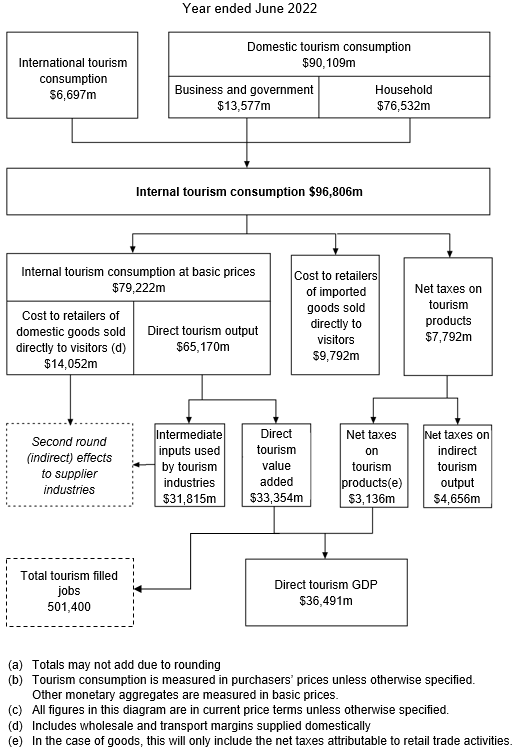| 2020-21 (a) | 2021-22 | |||
|---|---|---|---|---|
| $m | $m | % change | ||
| Gross Domestic Product (GDP) | ||||
| Current prices | 27,800 | 36,491 | 31.3 | |
| Chain volume measures | 27,800 | 35,136 | 26.4 | |
| Gross Value Added at basic prices | ||||
| Current prices | 25,751 | 33,354 | 29.5 | |
| Chain volume measures | 25,751 | 32,102 | 24.7 | |
| Domestic consumption | ||||
| Current prices | 79,660 | 90,109 | 13.1 | |
| Chain volume measures | 79,660 | 84,971 | 6.7 | |
| International consumption | ||||
| Current prices | 791 | 6,697 | 746.6 | |
| Chain volume measures | 791 | 6,415 | 711.0 | |
| Filled jobs '000 | 412,600 | 501,400 | 21.5 | |
(a) As the reference period for chain volume measures is 2020-21, chain volume measures and current prices are identical in 2020-21.
| 2018-19 | 2021-22 | |||
|---|---|---|---|---|
| $m | $m | % change | ||
| Gross Domestic Product (GDP) | ||||
| Current prices | 60,271 | 36,491 | -39.5 | |
| Chain volume measures | 61,910 | 35,136 | -43.2 | |
| Gross Value Added at basic prices | ||||
| Current prices | 55,186 | 33,354 | -39.6 | |
| Chain volume measures | 56,685 | 32,102 | -43.4 | |
| Domestic consumption | ||||
| Current prices | 113,021 | 90,109 | -20.3 | |
| Chain volume measures | 115,687 | 84,971 | -26.6 | |
| International consumption | ||||
| Current prices | 39,326 | 6,697 | -83.0 | |
| Chain volume measures | 40,740 | 6,415 | -84.3 | |
| Filled jobs '000 | 701,100 | 501,400 | -28.5 | |
